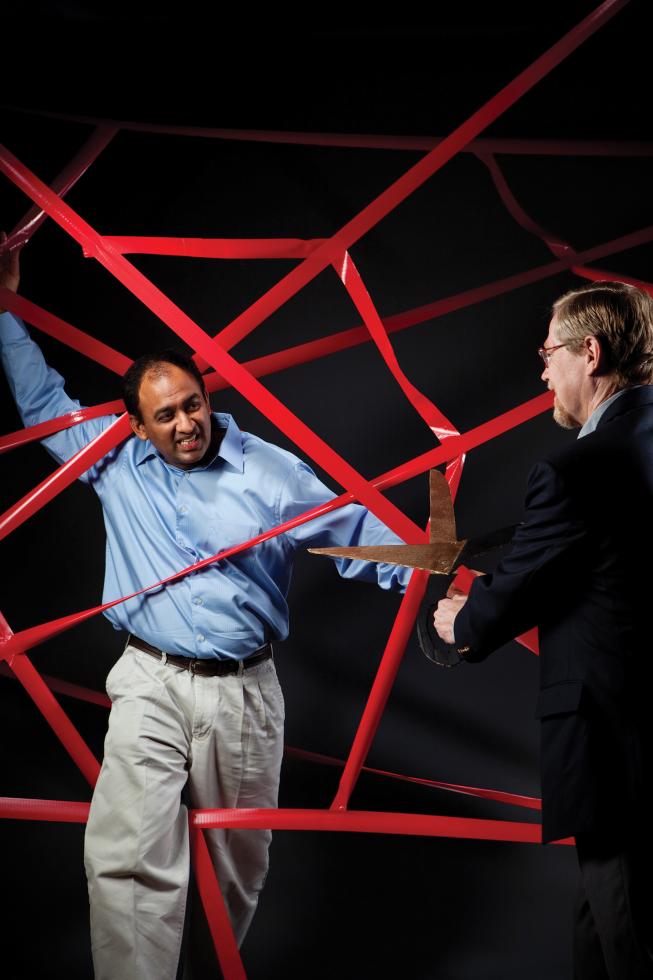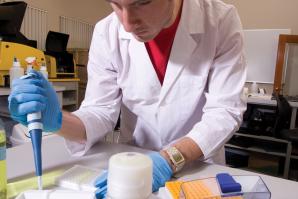Vikram Janardhan, CEO, Insera Therapeutics; and Cary Adams,
founder of, Proximal Ventures.

After four quarters of increasing venture investment, 2010 is off to a slow start. Venture capitalists invested $4.7 billion in the year’s first quarter, down from $5.2 billion in the fourth quarter of 2009, according to PricewaterhouseCoopers. The life sciences sector, including biotechnology and medical device industries, took the biggest hit with a 26 percent decline in venture investment over the previous quarter.
Entrepreneurs and venture capitalists alike have a rocky road ahead when it comes to raising funds. The economy is largely to blame — pensions have retracted their appetites for risk and are investing less in venture funds, to cite one example. Meanwhile, the venture money that is flowing has been redirected to fewer, stable, late-stage companies that can offer financiers a shorter wait for a return on investment.
“The economy has been brutal, and it’s been almost impossible for companies to get their first stage of funding,” says Cary Adams, founder of Proximal Ventures in Sacramento and a member of Sacramento Angels. “Why put venture capital into a new company when you could put it into a later-stage company for the same price and greater ownership?”
Venture capital investment peaked in 2000 with 7,986 deals nationwide totaling $100.4 billion, according to PricewaterhouseCoopers and the National Venture Capital Association. The number of investments dropped precipitously the following year to just 4,556 deals totaling $38.5 billion and have continued to decline most years since. Last year, just 2,868 deals were penned for a cumulative $17.8 billion, the groups report.
Even so, as venture investing declines, life sciences continues to be the No. 1 sector for such investments. Of the $4.7 billion spent this year, $825 million has gone to biotechnology companies in 99 deals. Medical device and equipment companies, while witnessing a 29 percent decline in funding over last quarter, still amassed $517 million in 61 deals.
For Sacramento entrepreneurs, it’s the silver lining in an otherwise cloudy venture market. “Sacramento suffered in terms of funding. It just dried up. The funding for startups just came to a halt,” says Pete Bernardoni, managing partner of Wavepoint Ventures in Sacramento. “Its picking up though, and clearly the money is starting to flow again,” Bernardoni says.
Besides the economy, the hiccup in the venture capital market was largely the result of all the question marks and what-ifs surrounding the president’s national health care plan.
“It’s improving, but its going to take time,” Bernardoni says. “Getting the bill finalized helped, and most investors view it as a positive. There is going to be a lot of stress put on our health care system. How is it going to absorb 20 million new Medicaid patients? Something has to change, and I think that something is innovation.”
As such, Wavepoint is bullish on medical device opportunities. “We’ve been doing this for a while, and we think there is going to be much more opportunity. That’s where the biggest chunk of investment is focused right now,” Bernardoni says. “It’s a great time for these startup medical technology companies. The bigger companies have cut their [research and development] budgets, and they have to have new products and technology. If they aren’t doing it internally, it means they have to go out and buy it, so there is going to be a pretty healthy [mergers and acquisitions] market going forward for quite a while.”
That’s good news for companies like Insera Therapeutics. The three-year-old Sacramento startup created a microtechnology for stroke victims — a tiny umbrella inserted into the femoral artery, which travels into the brain, pops open and removes the problematic blood clot. The product would cost consumers about $3,000. The company anticipates obtaining its main patent by the end of this year and has already completed more than 140 tests on the product, including five human trials.
The company anticipates needing roughly $23 million to get its product to market, and company officials hope they can give investors a quick return. “We are adapting to the realities of today’s capital market,” by cutting costs and offering investors rapid returns on small, staggered investments, says Insera chief executive Vikram Janardhan. While many medical technology and device companies need $20 million to $50 million in investment and years of patience before backers see a return, Insera anticipates a return on investment just months after pulling together only $5.5 million.
Janardhan and his business partner and brother, Dr. Vallabh Janardhan, a Harvard-trained neurologist, launched their company at the start of the recession. Just months into their venture, the economy tanked, the health care overhaul conversation began and the partners decided on a less conventional business model to address their impending struggles.
Entrepreneurs and venture capitalists alike are circumspect but optimistic about the federal health care bill, acknowledging the benefits of adding 32 million new consumers to the medical system. However, there will be some massive growing pains, the most immediately unpleasant of which will be a $20 billion excise tax levied on the medical device industry.
“This is one of the ways that the government has figured out how to pay for this bill. It’s an especially damaging tax because its taxing revenue, not profit. And there is no floor,” says Lisa Suennen, managing member of Psilos Group Managers LLC in Corte Madera. “Everyone from Medtronic to some guy who sold his first device yesterday will be subject to this tax. It can be really damaging for small companies.”
“Big companies go shopping. Their plans to buy have not changed, and Obama Care is not going to change that either. We’re not afraid. We’re going to save lives, and there will continue to be opportunities.”
Vikram Janardhan, CEO, Insera Therapeutics
The medical device excise tax aims to raise $20 billion (down from an original $60 billion) over 10 years when it goes into effect in 2013 and will apply to a wide range of medical device products.
“There is a lot of heartburn about this excise tax. It’s 2.3 percent, so go ahead and add that to the 40 percent in taxes you’re already paying,” says Vikram Janardhan. “You don’t go into biotechnology because you think the regulations are going to be easy; 2.3 percent is minor, so get over it. This is the new world.”
But some companies can’t get over it. In a March news release, Medtronic Inc. announced the tax would cost the company roughly $150 million to $200 million annually beginning in 2013 and would eat away at the company’s research and development budget, at minimum. And for many venture capitalists, who already see the medical device and technology sector as risky, the addition of new taxes and regulation could be the last straw.
The excise tax won’t be the only setback for medical device and technology companies. The path for funding and moving a device or technology from conception to market is akin to running the gauntlet, and it’s only getting harder.
As part of the president’s health care bill, the federal government has allocated $1.1 billion to fund comparative effectiveness research and the Federal Coordinating Council for Comparative Effectiveness Research.
Comparative effectiveness research is the process of determining which treatments, technologies, drugs and devices work better than others for the price. Such research also takes into consideration populations and whether subgroups of patients will benefit or be harmed by specific interventions. Results have long been used to inform providers, payers, regulators and consumers. But with the cost increases payers are anticipating experiencing as a result of the health care bill, many in the investment and medical technology industries are concerned that reimbursement decisions will be based on whether a product works and the incremental benefit it delivers relative to its incremental cost. Without reimbursement assurance, investors won’t commit.
Government and private insurers are placing unprecedented pressures on life sciences companies to demonstrate value for the products they develop, according to Ernst & Young, which said in a 2009 market report: “Insurers, governments and individuals are likely to increase demands to demonstrate value in the years ahead, as they confront mounting health care costs, a shrinking tax base, aging populations, and a mandate to provide care for a larger pool of citizens.”
Still, some investors see the comparative effectiveness challenge as weeding the weak from the strong. “As an investor, I want to fund something that really makes a difference and provides better medicine and a fair cost,” Bernardoni says. “I think it’s fair play that a product needs to stand up against its competition.”
And the competition is fierce. Since the start of the recession, the medical technology sector’s financial performance has largely held steady. The revenues of publicly traded med-tech companies in the U.S. and Europe grew 11 percent to $289 billion, according to Ernst & Young. At the same time, the company said in a 2009 industry report: “Increased unemployment has diminished tax revenues for many government-sponsored health programs. With their budgets under pressure, many private and public payers adopted aggressive cost-reduction measures, which have increased pricing pressures. The bottom line is that many med-tech firms selling big-ticket and discretionary items have seen orders decline.”
Between the taxes, the FDA requirements and the reimbursement headaches, a number of companies, including some in Sacramento, are choosing to do business elsewhere, at least to start.
“Globalization is an advantage to people who aren’t threatened by it,” says Vikram Janardhan. It’s the strategy the Janardhans are using to launch their product and get money back into the hands of investors in a fraction of the time it would take in the states — and for an estimated 40 percent reduction in costs. Once Insera manages to make some money in countries like India, Brazil and the United Kingdom, it will bring its product back to the states with enough money and data to make the regulatory hoops in America worth the effort.
What’s all the headache and spending worth? A potential increase of 32 million new consumers ushered into the health care system by the federal overhaul.
“I think it will work out positively. … There will be a greater variety and depth of diseases to handle,” says Vikram Janardhan. “It will make the products more robust. If more people are able to use your device, it becomes more versatile. In the long run, it will be terrific.”
More patients means more insurance to pay the bills. And the bill’s many steps to reign in the harsh insurance practices, such as caps on yearly or lifetime coverage and denying insurance for pre-existing conditions, also spells more opportunities for medical device and technology companies.
“I look at the current environment as separating the weak. There are a lot of guys whining out there, but you should wear your success through ’08 and ’09 as a badge of honor. We started at the end of 2007, and here we are — and we’re confident,” Janardhan says. “Big companies go shopping. Their plans to buy have not changed, and Obama Care is not going to change that either. We’re not afraid. We’re going to save lives, and there will continue to be opportunities.”
Recommended For You

Venturing Out
Finding funding for tomorrow's med tech innovations
The team at Davis-based Gold Standard Diagnostics Inc., which sells disease test kits, automated instruments and regulatory services, noticed an opportunity in the medical laboratory industry to build an instrument that would automate not only the test kits it was offering, but those of other suppliers as well, allowing labs to consolidate to one instrument and improve efficiency, says John Griffiths, chief executive officer.

Genetically Engineered Industry
The Capital Region holds promise for agricultural technology
A few months after the 2002 launch of Arcadia Biosciences Inc. in Phoenix, CEO Eric Rey insisted the company move to California. Not to Silicon Valley, but to Davis.


